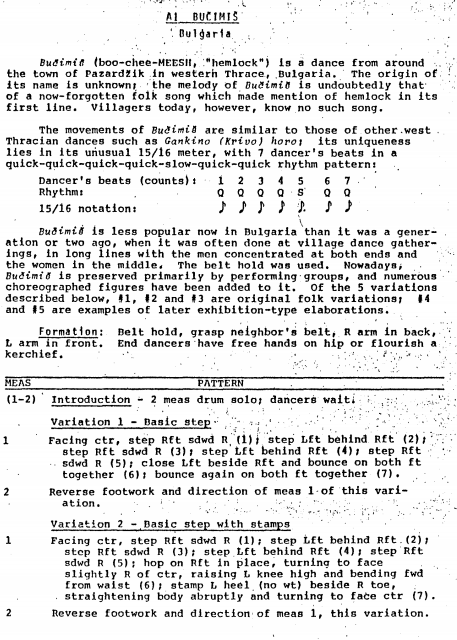*1st Generation dance. A dance that developed in a traditional way – not ‘taught’ by a teacher or choreographer, but ‘learned’ by observing and imitating others in your “village”, where the village’s few dances were the only dances anyone knew. It usually is ‘generic’ – the dance pattern is fairly simple and not tied to any particular piece of music. The dance phrase may or may not match any musical phrase, but the music’s rhythm must be suitable for performing the footwork. This dance may have many variations, but they’re performed at the whim or inspiration of the leader or (sometimes) any other dancer so long as it doesn’t interfere with the flow of neighboring dancers. For more, click here, here, and here.
Bučimiš origins
Bučimiš (boo-chee-MEESH) is one of over 30 different Bulgarian words for the poison hemlock plant, Conium maculatum – the same plant that killed Socrates. The plant is common all over Bulgaria, and much of the rest of the world as well. However this website https://bgflora.net/families/apiaceae/conium/conium_maculatum/conium_maculatum.html supposedly representing Bulgaria as a whole, calls the plant Buchinish, with an “n” (according to a Google translation). The website goes on to say Bučimiš (with an “m”, is the way Bulgarians spelled hemlock in the Kukush area. According to Wikipedia, Kukush (Кукуш) is the Bulgarian name for a 3000+ year-old settlement – what is now called Kilkis in Greece.

The area was ruled by Philip and Alexander the Great of Macedonia, then the Romans, who evolved into the Byzantines. Goths, Huns, Avars & Slavs invaded, Bulgarians consolidated their control, then wrestled with the Byzantines (Greeks) for a few centuries until the Ottoman Turks took over in 1430. Under Ottoman rule the population was mostly Bulgarian, with Turkish, Greek & Roma minorities. In 1912 Bulgaria expelled the Turks, and the area became officially Bulgarian. For about a year. In 1913 the Greeks defeated the Bulgarians, destroyed the town, and sent its 13,000 Bulgarians to Bulgaria – most of whom settled around Pazardzhik, near Plovdiv, Western Thrace.

At the same time, Greeks were being expelled from Serbia (Strumica), Bulgaria, and soon (1923) Anatolia, so Kukush was resettled, rebuilt and renamed. Today Kilkis is populated mostly by Greek-speaking people whose heritage is from outside of Greece.
No one seems to know what this plant the Kukush called Bučimiš has to do with this dance. According to the 2009 Folk Dance Problem Solver “Dick Crum speculated that the name Bučimiš came from a song that mentioned hemlock in its first line (NAMA record notes). No one knows that song now.” Nowadays, Bulgarians say Bučimiš is a dance from Thrace.
Bučimiš music
There are many YouTube versions of music called Bučimiš. All of them are instrumentals – none have lyrics. Melodies vary, but all have a common rhythm – 15/16 to us Westerners, or QQQQSQQ to traditional Balkan musicians. For a more detailed explanation of the rhythm, see https://folkdancefootnotes.org/dance/dance-information/bulgarian-dance-rhythms/ Here’s a couple of examples;
This group is from Plovdiv, Thrace.
There’s even a Bučimiš by a children’s choir “singing” everything BUT words.
I have lots more examples of Bučimiš music videos here https://wordpress.com/page/folkdancefootnotes.org/2300
Sheet music can be found here folkdancefootnotes.org/music/sheet-music/bucimis-sheet-music/
Bučimiš dance
As for the dance, Bučimiš it is what I call a 1st Generation dance. I can’t find any YouTube examples of it being danced in a “village” setting in Bulgaria. Dick Crum states below* that it was hard to find villagers dancing it 40+ years ago, so I hesitate to call it Living. However no one disputes that its origins were in Bulgarian villages, and Bulgarian performing groups are still proudly dancing it.
A Bučimiš performed at “The Feast of Bread” 07.07.2014, village of Orizare. Splashy formations disguise simple footwork.
The club Accent has 4 postings of Bučimiš on YouTube. Here’s a good view of their choreography – quite a bit more complicated than the group above.
Same Accent club at the National Dance Festival “Thracian Rosary” Pazardzhik, 2010 – I count about 50 dancers!
The group Trakia (Thrace) performing a Bučimiš followed by a Kopanitsa. Their version of Bučimiš takes some liberties with the side-to-side format for a more flamboyant “show”, and many variations are not familiar to Recreationalists, but they retain the basic 4-to-the-right, 4-to-the-left format.
This looks like some performers practicing.
I believe the dancers above are imitating the Professional version below. The Pros are in in Thracian costumes and dance a slow, Thracian tempo. Their main difference is they do two sets of steps to either side.
Some performers in Belgrade, Serbia. Looks like showmanship has completely trumped authenticity, at least in terms of formation. It still has that 15/16 rhythm, though.
In North America, various choreographies labeled Bučimiš have been taught, from the early 1960’s on, by Dennis Boxell, Dick Crum, Gordon Engler, Marcus Moskoff, Richard Unciano, Bruce Mitchell, Jaap Leegwater, Iliana Bozhanova and probably others. Crum’s version seems to have been the one most dance groups settled on. Although he states that the number and order of the variations is up to the leader’s discretion, most groups have lapsed into the order as written in his notes.
Here’s the most common Recreational version, the “Dick Crum” version, first with the music slowed down, then at regular speed.
Bučimiš in Israel. Similar, but more “stamps”, less “touches”.
*Dick Crum’s notes from the 1st NAMA album, 1974. Crum’s notes imply only the 1st 3 variations are the “village” version. Interestingly, they show up in almost all the groups shown; Bulgarian and Recreational.



The notes below add more variations, plus gives them Bulgarian names.
http://www.folkdance.com/LDNotations/Bucimis1987LD.pdf
Iliana Bozhanova taught another version recently.
